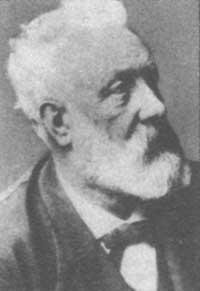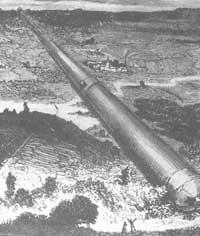Is the dream of Jules Verne a reality?

However, in North America four researchers have presented a curious project, more like the pitcher of von Braun, of the Jules Verne canyon.
In the last thirty years, in North America, different groups have tried to give “release speed” to small payloads with compressed gas cannons. (The speed of release is the initial speed necessary to put a load in orbit around the Earth and according to the launch point it is usually 7.9 to 11.1 km/s). In the tests carried out to date, the speed has not exceeded 10 km/s and the energy performance has been very bad: Between 1% and 2%. In other words, kinetic energy or speed has become 2% of the fuel.
There is another type of cannon called railgun. In them, the payload is strengthened in an increasingly larger magnetic field, but while the superconductive materials are no more accessible than now, the energy performance is very low and the magnetic windings deteriorate rapidly.
At the University of Washington (Seattle), however, another type of gun has been projected, the ram accelerator. It is a statorreactor mounted basically in an oil pipeline. The statorreactor is called ramjet and we can say that it is not a turbojet with turbine or compressor, that is, without almost mobile elements.

Above the speed Mach 2 (overcoming twice the speed of sound), the air that is ingested in this engine collides against an obstacle like the plug behind it, obtaining enough pressure for the fuel to turn on spontaneously without any compressor. In addition, if this engine is manufactured an adequate atmosphere and with lower sound speed, it will work better.
Based on this, the Washington team has filled the steel tube of 12.2 meters in length and 38 mm in diameter, a mixture of methane and oxygen in variable proportion diluted in inert gases (helios or carbon oxides (IV)) to 50 atmospheres. By means of a compressed gas cannon or a small gunpowder engine at 0.7 km/s, the projectile in the shape of a howitzer is inserted into the pipe by drilling the ultra-thin plastic diaphragm. Inside the pipe the projectile generates shock waves in the artificial atmosphere.
The profile and shape of the projectile are well studied. The conical wave that appears in the front does not heat enough to ignite the gaseous mixture. Another transversal wave is perpendicular to the obus, which compresses the gaseous mixture to the point of burning with a small lighter. Between this transversal wave and a subsequent narrowing according to the projectile or the third wave, there is a zone of high pressure and temperature. While hot gases cross the obstacle, the projectile is driven violently. This system uses only the energy needed to introduce the projectile to the cannon and the energy of the shock waves that are generated around it, without there being any other mobile piece.

There is also a projectile without this small lighter. In this case, in the middle of the projectile there is a highlight of one millimeter. The shock wave located at the end of the projectile is reflected in the wall of the tube, giving rise to the shock wave of the second. The gas is compressed until the explosion between the reflected wave and the second wave. The combustion gases go back and the projectile advances.
However, as the speed of the projectile increases, this high-pressure zone is increasingly advanced and slows down. The maximum speed of the projectile would be between 1500 and 2000 m/s.
Washington researchers have used 127 mm long magnesium projectiles and 28.9 mm diameter (100 grams), reaching a speed of 1.2 km/s with an acceleration of 20000 g, but with a lighter projectile it is expected to reach a speed of 3 km/s.
However, although so far the sessions have been carried out in very small dimensions and dimensions, the canyon of about three kilometers of length can be carried out as easily as any pipeline and a space of two tons could be placed to 10 km/s in orbit of 400 km of height. Since the high pressure zone would move along with space, it could be expected that the internal wear of the barrel would be distributed along the entire length, thus avoiding hundreds of shots without remedies.

Another problem is the friction heating of space through the atmosphere. This can be solved by placing the canyon about 4500 meters high. Thus, the thermal absorbent of the space would represent 1% of the total mass and the surface temperature would not exceed 1600ºC. Atmospheric friction, on the other hand, would reduce the speed of displacement given by 10%.
Another of the limits of the canyon is the acceleration of the projectile or space, but the designers estimate that 70% or 80% of the materials necessary for the construction of a large space station can be emitted with ram accelerator and at a cost much lower than that of any other system.
Buletina
Bidali zure helbide elektronikoa eta jaso asteroko buletina zure sarrera-ontzian











